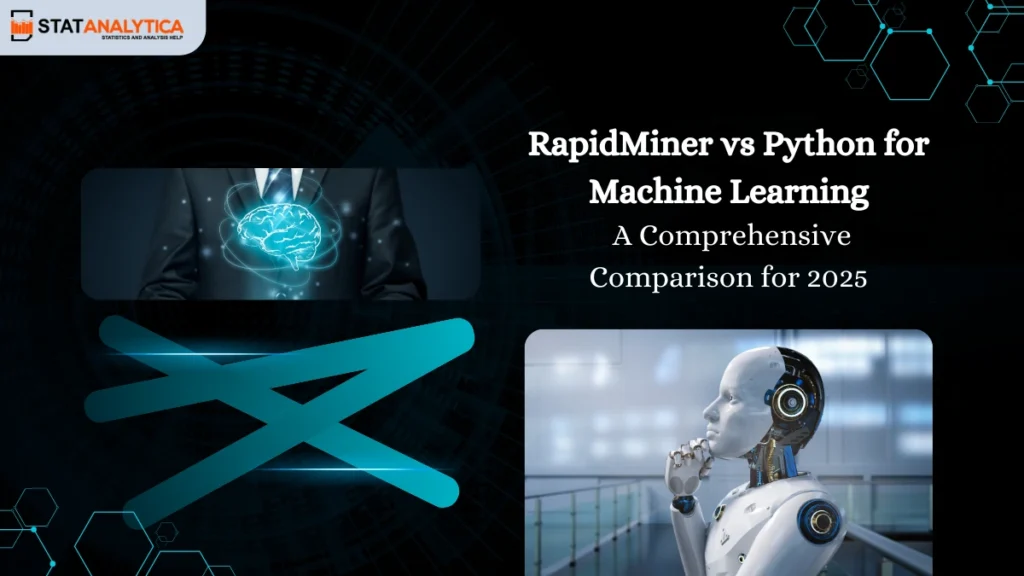Machine learning is transforming industries, revolutionizing how businesses analyze data, make predictions, and automate processes. With countless tools available, selecting the right one can be challenging. Among the most popular choices are RapidMiner and Python—two powerful platforms that cater to different user needs. But how do you decide which one is the best fit for your project?
In this comprehensive comparison, we will explore the key differences, advantages, and use cases of RapidMiner vs Python for machine learning to help you make an informed decision. Whether you’re a beginner looking for an easy-to-use platform or an experienced data scientist seeking full control over machine learning models, this guide will provide you with valuable insights.
RapidMiner vs Python for Machine Learning
Table of Contents
What is RapidMiner?
RapidMiner is a no-code/low-code data science platform that makes the machine learning process much easier. It offers a visual programming interface that enables users to create detailed models with scarce coding. Thus, it is perfect for business analysts or anyone who does not necessarily need to have programming experience, as well as data science teams who want a fast and easier way to do large-scale analytics.
Key Features of RapidMiner
- User-friendly Interface: Visual workflow designer for easy model creation.
- Pre-built Machine Learning Algorithms: Includes classification, regression, clustering, and deep learning models.
- Data Preparation Tools: Automated data cleaning, transformation, and feature selection.
- Enterprise Integration: Supports database connections, cloud services, and Python/R integration.
- Collaboration Features: Team collaboration with version control and model sharing.
- Automated Machine Learning (AutoML): RapidMiner provides automated model selection, hyperparameter tuning, and feature engineering.
- Security and Governance: Offers role-based access control, audit trails, and compliance tracking, making it suitable for large enterprises.
- Deployment Options: Models can be deployed on-premise, in the cloud, or integrated with existing business systems.
Who Should Use RapidMiner?
- Business analysts and non-programmers
- Organizations needing quick deployment
- Data scientists prefer a visual approach
- Enterprises requiring built-in governance and security
Pros of Using RapidMiner
✅ No programming skills required ✅ Fast and efficient data processing ✅ Supports multiple machine learning techniques ✅ Offers integration with Python and R for flexibility ✅ Great for teams collaborating on machine learning projects ✅ Advanced automation reduces manual work ✅ Built-in visualization and reporting tools
Cons of Using RapidMiner
❌ Limited deep learning capabilities compared to Python ❌ Licensing costs for advanced features ❌ Less control over model customization ❌ Not as widely used in AI research
What is Python?
Python is the most popular programming language for machine learning, offering vast libraries and flexibility for AI development. It is widely adopted in academia and industry due to its open-source nature and active community support.
Key Features of Python for Machine Learning
- Extensive Libraries: scikit-learn, TensorFlow, PyTorch, Keras, Pandas, NumPy, etc.
- Customization: Full control over algorithms and workflows.
- Integration with Big Data and Cloud: Compatible with Hadoop, Spark, AWS, and Google Cloud.
- Strong Community Support: Large developer base and continuous improvements.
- Open-source and Free: No licensing cost, making it a cost-effective choice.
- Supports Deep Learning: TensorFlow and PyTorch provide advanced deep learning capabilities.
- Flexibility: Can be used for web applications, automation, and software development in addition to machine learning.
- Wide Adoption in Research: Used in AI, bioinformatics, finance, and robotics.
Who Should Use Python?
- Developers and programmers
- Data scientists requiring advanced model customization
- AI researchers working on cutting-edge algorithms
- Companies developing AI-powered applications
- Businesses working with large datasets and big data analytics
Pros of Using Python
✅ Large open-source ecosystem ✅ Full control over ML models ✅ Highly scalable and flexible ✅ Ideal for deep learning and AI research ✅ Strong industry adoption and job market demand ✅ Excellent support for big data and cloud computing ✅ Strong community and extensive learning resources
Cons of Using Python
❌ Requires coding knowledge ❌ Steeper learning curve for beginners ❌ Processing speed can be slower compared to compiled languages like C++ ❌ Needs additional tools for visualization and model deployment
RapidMiner vs Python: Detailed Comparison
1. Ease of Use
| Feature | RapidMiner | Python |
| User-Friendliness | Easy drag-and-drop interface | Requires coding skills |
| Learning Curve | Beginner-friendly | Steeper learning curve |
| Customization | Limited | Highly flexible |
Verdict: RapidMiner wins for beginners and non-programmers, while Python is ideal for those who need full control over machine learning models.
2. Performance and Speed
| Feature | RapidMiner | Python |
| Speed | Faster for automated tasks | Optimized with parallel processing |
| Scalability | Limited | Highly scalable for big data |
| GPU Support | Limited | Supports GPU acceleration (TensorFlow, PyTorch) |
Verdict: Python is better for large-scale, high-performance applications.
3. Libraries and Algorithm Support
| Feature | RapidMiner | Python |
| Algorithm Variety | Built-in ML models | Extensive third-party libraries |
| Deep Learning | Limited | Supports TensorFlow and PyTorch |
| AI Research | Not suitable | Preferred for AI innovation |
Verdict: Python offers more advanced tools for deep learning and AI research.
4. Integration and Compatibility
| Feature | RapidMiner | Python |
| Database Support | SQL, Excel, Cloud | SQL, NoSQL, APIs |
| Enterprise Integration | Business-ready | Open-source integrations |
| Automation & Deployment | Limited | Supports Docker, Flask, FastAPI |
Verdict: Python excels in integrating with diverse technologies and deploying ML models at scale.
Final Thoughts: Which One Should You Choose?
While both RapidMiner and Python are great tools for machine learning, they serve different types of users. If you are working on a low code-based quantitative project, RapidMiner is a one-size-fit-all solution for you, which is quick and has an intuitive interface. On the other hand, if you are looking for more powerful customization and scalability, the choice here is Python – for developers, researchers, and data scientists.
For businesses and analysts, RapidMiner is the best choice for quick deployment.
For AI and ML experts, Python remains the gold standard.
Also Read: SQL vs MySQL: Key Difference Between SQL And MySQL
Which tool is better for long-term career growth?
Python is a better choice for long-term career growth as it is widely used in the industry and has extensive applications in AI, ML, and data science.
Can I use RapidMiner for big data projects?
RapidMiner has some big data capabilities, but Python is more scalable and suitable for large datasets.
Can I integrate Python with RapidMiner?
Yes, RapidMiner allows Python script integration, enabling users to combine the best of both worlds.


